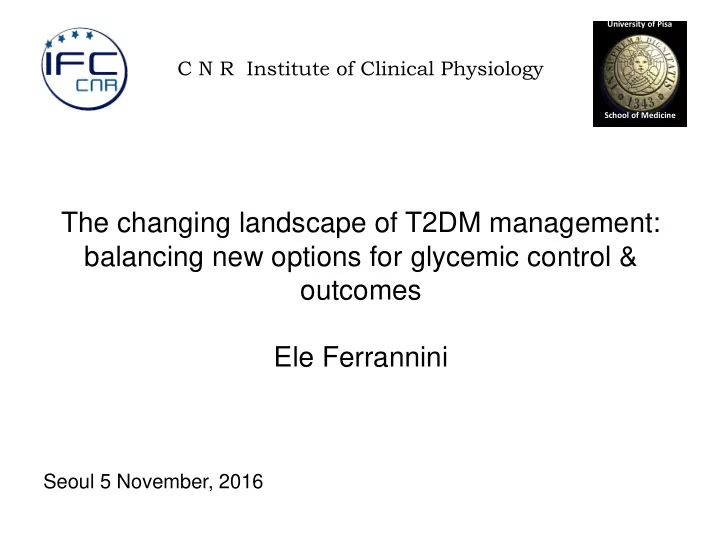

University of Pisa C N R Institute of Clinical Physiology School of Medicine The changing landscape of T2DM management: balancing new options for glycemic control & outcomes Ele Ferrannini Seoul 5 November, 2016
Diabetes Treatment Why? 1. Metabolic control 2. Microvascular complications 3. Macrovascular complications 4. Overall survival 5. Quality of life
Diabetes Treatment Why? 1. Metabolic control 2. Microvascular complications 3. Macrovascular complications 4. Overall survival 5. Quality of life
Diabetologist’s Issues Patient-centered approach Early treatment Combination treatment Compliance Therapeutic response
Diabetologist’s Issues Patient-centered approach Early treatment Combination treatment Compliance Therapeutic response
Heterogeneity re . comorbidities Obesity Hypertension Diabetes
Heterogeneity of Type 2 Diabetes • Autoimmune (LADA) & genetic background • Age of onset (the elderly) • Duration (ß-cell loss) • Ethnicity • Obesity • Circumstances (pregnancy, trauma, infections, HCV, etc.) • Previous treatments (steroids, neuroleptics, etc.) • Severity of presentation • Microvascular complications • Macrovascular disease
Heterogeneity of type 2 diabetes Response to Progression Treatment Pre-DM T2D Complications Presentation Development
Diabetologist’s Issues Patient-centered approach Early treatment Combination treatment Compliance Therapeutic response
Brief Insulin Course in New Diabetes Weng J, et al . Lancet 2008;371:1753-60
Absolute Risk Reduction (ARR) How early is early? UKPDS : Newly-diagnosed T2D, intensive vs conventional Tx: Diabetes-related mortality after 30 yrs RRR = 17%; ARR = 2.5%; NNT = 40 ORIGIN : Recent T2D, insulin vs SoC: neutral on CVD DCCT/EDIC : 1-5-yr duration T1D, 7-yr intensive vs conventional Tx: Total mortality at 27 yrs RRR = 33%; ARR = 2.7%; NNT = 37
Diabetologist’s Issues Patient-centered approach Early treatment Combination treatment Compliance Therapeutic response
Timeline of the Introduction of Treatment Options for Type 2 Diabetes SGLT2i DPP-4 Inhibitors Inhaled insulin GLP-1 Receptor Agonists Pramlintide Aspart Long Acting Insulin Analogs Glinides Thiazolidinediones -Glucosidase inhibitors Rapid Acting Insulin Analogs Human insulin Metformin Sulfonylureas Animal insulin 1922 1950s 1982-5 1995 1996 2001 2003 2005 2006 2007 2015
Combination therapy Treatments n = 7 n = 13 Doublets 21 78 Triplets 35 286 Quadruplets 35 715
Rational combinations Insulin + • SGLT2 inhibitors • GLP1-RA to reduce hypoglycaemia and curb weight gain or SGLT2 inhibitors + GLP1-RA to enhance weight loss and blood pressure lowering
Diabetologist’s Issues Patient-centered approach Early treatment Combination treatment Compliance Therapeutic response
Secondary metformin failure 1 0.9 <7% Proportion not experiencing 12.3%/year 0.8 7-7.9% secondary failure 0.7 17.8%/year 0.6 8-8.9% 19.2%/year 0.5 0.4 ≥9.0% 0.3 19.4%/year 0.2 0.1 0 0 4 6 8 10 12 14 16 18 20 22 24 26 28 30 32 34 36 38 40 42 44 46 48 50 52 54 5860 Months on metformin Brown JB, et al. Diabetes Care 2010;33:501-6
Compliance Dailey G, et al. J Int Med Res 30:71-79, 2002.
Factors Related to Nonadherence in Patients With Type 2 Diabetes 11% 8% Others* Cost Only 23% of patients who had side effects Difficulty in reported the problems to Side effects remembering their primary care physician 58% doses 23% *Number of prescribed medications, patient characteristics N=128 patients with Type 2 Diabetes. Grant RW, et al. Diabetes Care 2003;26:1408-1412
Diabetologist’s Issues Patient-centered approach Early treatment Combination treatment Compliance Therapeutic response
Therapeutic response: metrics What response? 1. Fasting plasma glucose 2. Random plasma glucose 3. HbA 1c 4. Body weight 5. Hypoglycaemic episodes
Therapeutic response: metrics How much response? Fasting plasma glucose decrease ≥1.5 mmol/L 1. Fasting plasma glucose ≤7.0 mmol/L 2. Random plasma glucose ≤11.1 mmol/L 3. HbA1c decrease ≥0.5% 4. Body weight decrease ≥5% 5. Hypo: ≤1 severe episode/year 6.
Therapeutic response: metrics When? 1. Six months 2. One year 3. Three years 4. Five years
Therapeutic response: metrics What response? 1. Fasting plasma glucose 2. Random plasma glucose HbA 1c + Body weight + Hypo’s 3. 4. Body weight 5. Hypoglycaemic episodes
Relationship between baseline HbA 1c and treatment-induced changes in HbA 1c DeFronzo RA, et al. Diabetic Med 2010;27:309-17
Non-responders: primary 1. Pharmacokinetics 2. Suboptimal dose 3. Genetics 4. Tachyphylaxis
Non-responders: secondary 1. Disease progression 2. ß-cell exhaustion 3. Weight gain 4. Acute medical/surgical events (= stress hyperglycaemia )
Identifying Responders and Non-responders Baseline HbA 1c is predictive of a good HbA 1c decrease • but not specific: a high HbA 1c is a predictor of response for all anti-diabetic agents, • and a better relative response does not translate into more achievers .
Identifying Responders and Non-responders Yes, but not specific Baseline HbA 1c and not helpful in clinical practice Age Duration of Diabetes Gender Body weight at baseline No predicting value, ß-cell function at least for clinical use Genetics Endogenous GLP1 secretion Endogenous DPP4 activity Pharmacokinetics
Therapeutic response: problems For whom? Physician’s satisfaction 1. Patient’s satisfaction 2. 3. Healthcare system compliance
Responders to an antidiabetic drug: what does it mean? There is no consensus to define the bad responders (or the good), on an individual basis, within this continuum of decrease The most commonly used criterium is «the achievers» The number of patients reaching the ADA/EASD HbA 1c target of 7% are considered as target achievers in clinical studies.
Diabetologist’s Expectations Better patient-specialist-primary care relation Earlier combination treatment based on drug mode of action Targeted CVD outcome trials in special populations Prevention: screening,deep phenotyping, and treatment of high-risk subjects
Recommend
More recommend